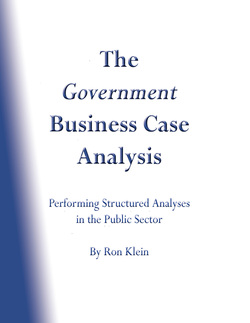About the Author:

Ron Klein
About the Book:

The Government Business Case Analysis:
Performing Structured Analysis in the Public Sector
Paperback, 8.5x11, 104 pages, $23.95
Every undertaking involves opportunity costs; that is, every hour spent in one endeavor is time that is not available for a myriad of other tasks. Finance 101 courses teach Return on nvestment (ROI) calculations, and public policy courses teach cost-benefit analyses. Scores of good finance texts exist, ranging from college textbooks to topics as specific as the
analyses and assessment of derivatives, and at least one excellent text specifically addresses Business Case Analysis (BCA) in corporate applications. So the question is, "Why write this book"? The answer is twofold. First, after performing
several BCAs for various federal agencies, Belzon analysts encountered a dearth of practical, hands-on guides to assist federal agencies in performing BCAs in the environment in which they operate. While texts tailored to corporate applications appropriately cover topics such as the value of extending one's brand and the tax consequences of decisions, such topics are not applicable to federal agencies. In addition, federal agencies encounter other difficulties, such as diffused authority and a lack of data-the absence of a comprehensive cost accounting system is just one example. Finally, large corporations are experienced in structured analyses and the BCA is often a relatively minor modification to existing tools and practices. Therefore, the first reason for this book is to provide step-by-step guidance for government analysts in structuring and performing BCAs, regardless of the government organization or the questions being asked. The second reason for writing this book is to advocate better governance of federal agencies. In our view, the two greatest impediments to improved government are indifference and a lack of understanding as to how to proceed. This indifference is born of many fathers, not the least of which is a lack of direction and knowing where to start. It is our hope that this book will provide substantive solutions to both impediments by providing step-by-step procedures for conducting a BCA. It is also our abiding desire
to provide assistance to those who want to undertake an assessment of how their agency performs its mission, to identify the advantages and disadvantages of the alternative means of performing the mission, and to develop a realistic vision of what can be achieved, as well as the necessary resources to accomplish the transition. Intended Audience The intended audience for this book is government personnel who execute or review BCAs-especially those who have never been involved in the conduct of a BCA, have had only a peripheral role, or infrequently participate in the analysis and documentation of a BCA. In addition, this guide is written to be useful to senior managers who direct the BCA, as well as those who will be performing the research and analyses.
Performing Structured Analysis in the Public Sector
Paperback, 8.5x11, 104 pages, $23.95
Every undertaking involves opportunity costs; that is, every hour spent in one endeavor is time that is not available for a myriad of other tasks. Finance 101 courses teach Return on nvestment (ROI) calculations, and public policy courses teach cost-benefit analyses. Scores of good finance texts exist, ranging from college textbooks to topics as specific as the
analyses and assessment of derivatives, and at least one excellent text specifically addresses Business Case Analysis (BCA) in corporate applications. So the question is, "Why write this book"? The answer is twofold. First, after performing
several BCAs for various federal agencies, Belzon analysts encountered a dearth of practical, hands-on guides to assist federal agencies in performing BCAs in the environment in which they operate. While texts tailored to corporate applications appropriately cover topics such as the value of extending one's brand and the tax consequences of decisions, such topics are not applicable to federal agencies. In addition, federal agencies encounter other difficulties, such as diffused authority and a lack of data-the absence of a comprehensive cost accounting system is just one example. Finally, large corporations are experienced in structured analyses and the BCA is often a relatively minor modification to existing tools and practices. Therefore, the first reason for this book is to provide step-by-step guidance for government analysts in structuring and performing BCAs, regardless of the government organization or the questions being asked. The second reason for writing this book is to advocate better governance of federal agencies. In our view, the two greatest impediments to improved government are indifference and a lack of understanding as to how to proceed. This indifference is born of many fathers, not the least of which is a lack of direction and knowing where to start. It is our hope that this book will provide substantive solutions to both impediments by providing step-by-step procedures for conducting a BCA. It is also our abiding desire
to provide assistance to those who want to undertake an assessment of how their agency performs its mission, to identify the advantages and disadvantages of the alternative means of performing the mission, and to develop a realistic vision of what can be achieved, as well as the necessary resources to accomplish the transition. Intended Audience The intended audience for this book is government personnel who execute or review BCAs-especially those who have never been involved in the conduct of a BCA, have had only a peripheral role, or infrequently participate in the analysis and documentation of a BCA. In addition, this guide is written to be useful to senior managers who direct the BCA, as well as those who will be performing the research and analyses.